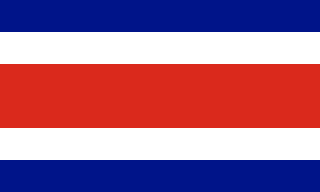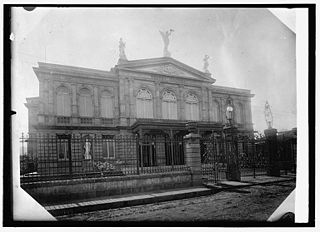
Costa Rica, officially the Republic of Costa Rica, is a country in the Central American region of North America. Costa Rica is bordered by Nicaragua to the north, the Caribbean Sea to the northeast, Panama to the southeast, and the Pacific Ocean to the southwest, as well as maritime border with Ecuador to the south of Cocos Island. It has a population of around five million in a land area of 51,060 km2 (19,710 sq mi). An estimated 333,980 people live in the capital and largest city, San José, with around two million people in the surrounding metropolitan area.

The "Himno Nacional de Costa Rica", also known by its incipit, "Noble patria, tu hermosa bandera", is the national anthem of Costa Rica. Its music was composed by Manuel María Gutiérrez Flores, who dedicated the score to French adventurer Gabriel-Pierre Lafond de Lurcy, and adopted in 1852. The music was created to receive delegates from the United Kingdom and the United States that year for the Webster-Crampton Treaty. It was the first Central American national anthem.

The University of Costa Rica is a public university in the Republic of Costa Rica, in Central America. Its main campus, Ciudad Universitaria Rodrigo Facio, is located in San Pedro Montes de Oca, in the province of San José. It is the oldest and largest institution of higher learning in Costa Rica, originally established as the Universidad de Santo Tomás in 1843. Approximately 45,000 students attend UCR throughout the year.

William Le Lacheur or Guillaume Le Lacheur, was a Guernsey sea captain who played an important role in the economic and spiritual development of Costa Rica.

Education in Costa Rica is divided in 3 cycles: pre-education, primary education, and secondary school, which leads to higher education. School year starts between the second and third week of February, stops at the last week of June, it continues again between the third and fourth week of July and finishes between the last week of November and the second week of December. Preschool and basic education are free to the public. Elementary and secondary school are both divided in two cycles. Since 1869, education is free and compulsory.

The National Stadium of Costa Rica is a multi-purpose stadium in La Sabana Metropolitan Park, San José, Costa Rica. It was the first modern sporting and events arena to be built in Central America. The stadium was completed in early 2011 and officially opened its doors to the public on March 26 of that year, with a capacity of 35,175 seats. The stadium replaced the original National Stadium, and is the home stadium of the Costa Rican national football team.

Relations between Costa Rica and the United States have been historically close; nevertheless there were instances in history where the US and Costa Rica disagreed. One such example might be the case of Freebooter William Walker. Nevertheless, considering that Costa Rica generally supports the U.S. in international fora, especially in the areas of democracy and human rights, modern day relations are very strong.

The 1949 Constitution of Costa Rica established two vice-presidencies of Costa Rica, which are directly elected through a popular vote on a ticket with the president for a period of four years, with no immediate re-election. There has been various incarnations of the office. Vice presidents replace the president in cases of temporary or permanent absence.

Christianity is the predominant religion in Costa Rica, with Catholicism being its largest denomination. Catholicism is also the state religion, but the government generally upholds people's religious freedom in practice.
Rodrigo Alberto Carazo Zeledón is a Costa Rican politician, economist, lawyer and political scientist who was elected in June 2022 to a four-year term as a member of the UN Human Rights Committee by the state parties to the International Covenant on Civil and Political Rights. He was Costa Rica's representative to the United Nations from 2018 to 2022, having presented his credentials the 31st of August 2018. He was the first Ombudsman of the Republic of Costa Rica and a former delegate to the Legislative Assembly of Costa Rica who served in that capacity during the Pacheco administration. He was president of the Partido Acción Ciudadana.
Alberto Cañas Escalante was a politician, writer, intellectual, public servant, and journalist from San José, Costa Rica. He is known as one of the most important figures in the cultural, political, and social life of Costa Rica during the latter half of the twentieth century. The National Library System of Costa Rica credits Cañas with more than 4,773 publications as of 2005.
Víctor Miguel Coto Ortega is a Costa Rican footballer. He is the first Costa Rican to have ever played in the S.League.
Juan Manuel Villasuso Estomba is a Costa Rican politician, writer and civil servant. He is a former member of the National Liberation Party and a current member of the Citizens' Action Party.
At the 2011 census, the number of immigrants in Costa Rica totaled about 390,000 individuals, or about 9% of the country's population. Following a considerable drop from 1950 through 1980, immigration to Costa Rica has increased in recent decades.

The Constitution of Costa Rica is the supreme law of Costa Rica. At the end of the 1948 Costa Rican Civil War, José Figueres Ferrer oversaw the Costa Rican Constitutional Assembly, which drafted the document. It was approved on 1949 November 7. Several older constitutions had been in effect starting from 1812, with the most recent former constitution ratified in 1871. The Costa Rican Constitution is remarkable in that in its Article 12 abolished the Costa Rican military, making it the second nation after Japan to do so by law. Another unusual clause is an amendment asserting the right to live in a healthy natural environment.

The First Costa Rican Republic is the name given to the historical period between the proclamation of the Republic of Costa Rica in the 1848 reformed Constitution and the official decree by then President José María Castro Madriz on 31 August 1848 and the Costa Rican Civil War of 1948 which ended with the enactment of the current 1949 Constitution on 7 November 1949 starting the Second Costa Rican Republic.

The Liberal State is the historical period in Costa Rica that occurred approximately between 1870 and 1940. It responded to the hegemonic dominion in the political, ideological and economic aspects of liberal philosophy. It is considered a period of transcendental importance in Costa Rican history, as it's when the consolidation of the National State and its institutions finally takes place.

The Reform State or Reformist State is the period in 20th-century Costa Rican history when the country switched from the uncontrolled capitalism and laissez-faire approach of the Liberal State into a more economically progressive Welfare State. It began about 1940 during the presidency of social reformer Rafael Angel Calderón Guardia, and ended in the 1980s with the neoliberal reforms inherent in the Washington Consensus that began after the government of Luis Alberto Monge.

Although the conservation movement developed in Europe in the 18th century, Costa Rica as a country has been heralded its champion in the current times. Costa Rica hosts an astonishing number of species, given its size, having more animal and plant species than the US and Canada combined hosting over 500,000 species of plants and animals. Despite this, Costa Rica is only 250 miles long and 150 miles wide. A widely accepted theory for the origin of this unusual density of species is the free mixing of species from both North and South America occurring on this "inter-oceanic" and "inter-continental" landscape. Preserving the natural environment of this fragile landscape, therefore, has drawn the attention of many international scholars and scientists.












